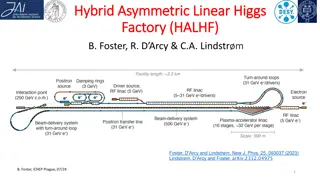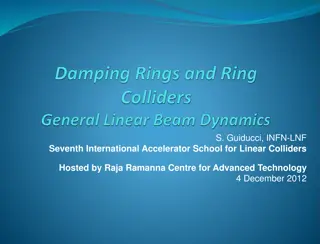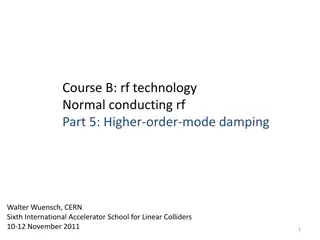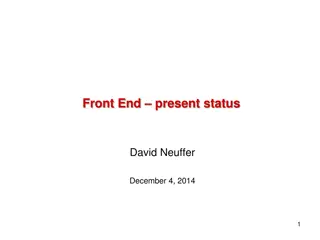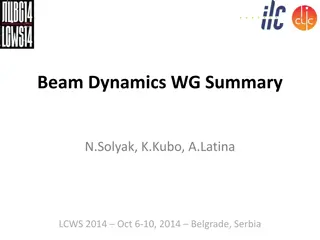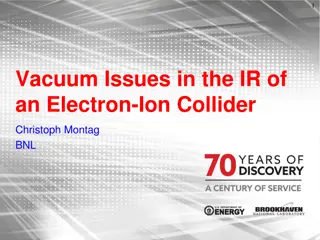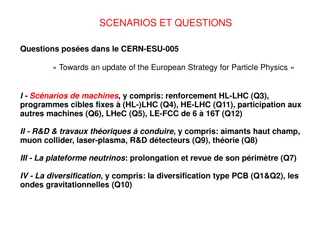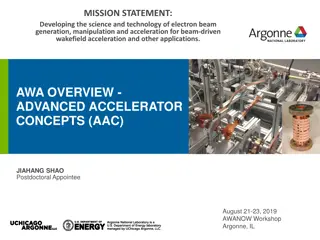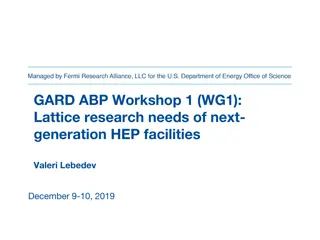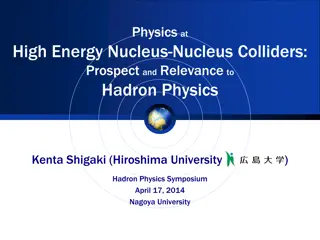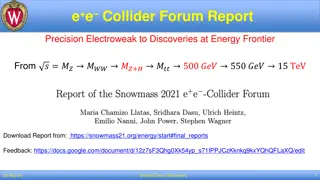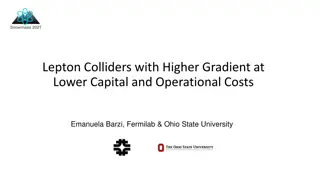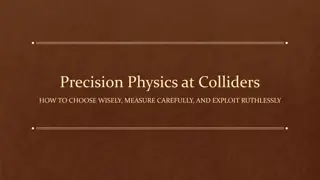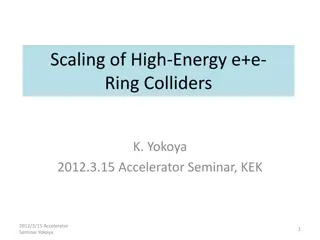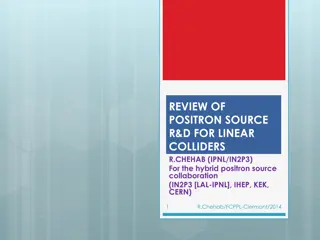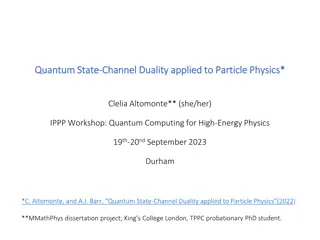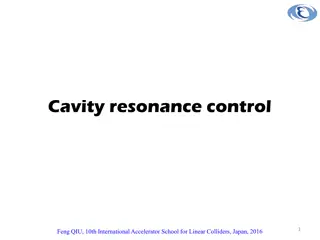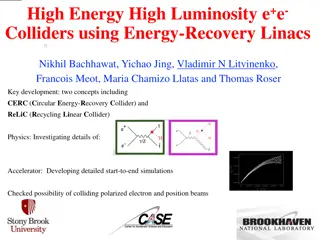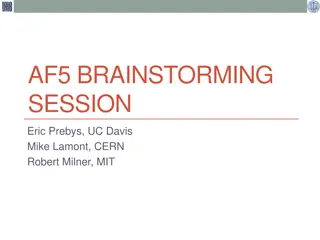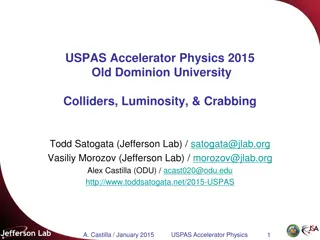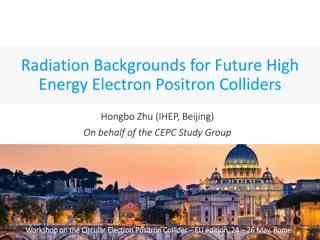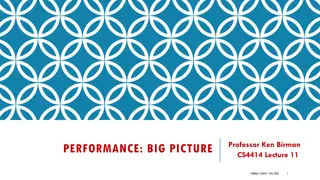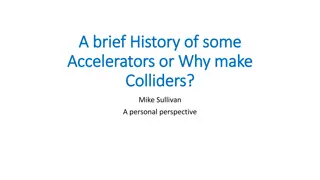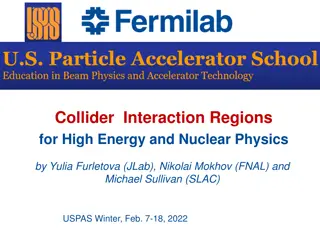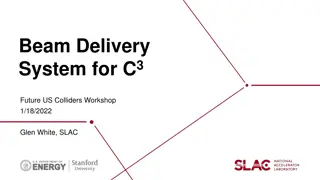High-Energy Recycling in E+ E- Colliders: Energy Recovery Linacs (ERLs) Advancements
High-energy recycling in E+ E- colliders involves the innovative concept of Energy Recovery Linacs (ERLs), pioneered by experts like Vladimir N. Litvinenko. These ERLs effectively recycle energy from collided beams, reducing energy consumption and increasing collider efficiency by maximizing luminos
3 views • 21 slides
New ILD Strategy: Consequences on ILD Tracking and Momentum Resolution
The ILD collaboration is adapting its strategy for potential circular colliders like FCC or CEPC, discussing challenges in tracking distortion correction, momentum resolution requirements, and handling various backgrounds. The focus is on optimizing the ILD design to meet the evolving collider lands
0 views • 11 slides
Innovative Hybrid Asymmetric Linear Higgs Factory (HALHF) Proposal
Cutting-edge proposal for the HALHF facility aiming to revolutionize particle acceleration technology by utilizing a hybrid asymmetric approach for electron-positron colliders. The design focuses on cost-efficiency and performance optimization, showcasing potential for significant advancements in hi
1 views • 18 slides
Overview of Damping Rings in Linear Colliders
This content provides insights into the basics of damping rings in linear colliders, covering topics such as ring equations of motion, betatron motion, emittance, transverse coupling, dispersion, and momentum compaction factor. It delves into the equations of motion governing particle behavior in el
4 views • 34 slides
Managing Higher-order Modes in Normal Conducting RF Technology
The excitation of higher-order transverse modes due to misalignments between the beam and RF structures can lead to beam instability in linear colliders. This instability can be mitigated by selectively damping the transverse modes and/or detuning the dipole mode frequencies. Understanding the diffe
3 views • 34 slides
Current Status of Front End Systems in Particle Collider Research
David Neuffer presented the current status of front end systems for particle colliders on December 4, 2014. The presentation covered various aspects like baseline examples, beam characteristics, drift mechanisms, cooling methods, and simulation results. It provided insights into the operational mech
1 views • 15 slides
Advanced Beam Dynamics and Machine Protection in High-Energy Linacs
Overview of recent talks and discussions at LCWS 2014 in Belgrade, Serbia, focusing on machine protection, simulation codes, instrumentation, and system tests. Topics include beam-loss monitors, dark current measurements, simulation code developments, and beam dynamics studies in linacs. Key speaker
6 views • 12 slides
Challenges and Upgrades in Electron-Ion Collider Interaction Regions
The article discusses vacuum issues, design challenges, and experiences in the interaction regions of Electron-Ion Colliders. It explores the unique characteristics of the HERA collider, including beam currents, bunch spacing, and straight sections. Additionally, it covers the upgrades and improveme
1 views • 25 slides
Update of European Strategy for Particle Physics: Scenarios and Questions
Briefing book by CERN's Physics Preparatory Group outlines the landscape of particle physics field and proposes five scenarios for future major colliders in Europe, including HL-LHC, CLIC, FCC, LHeC, and LE-to-HE-FCC-h/e/A. The book emphasizes the need for technology decisions and investments to rea
0 views • 6 slides
Advancing Electron Beam Technology for Accelerator Applications
Focusing on electron beam generation, manipulation, and acceleration, this initiative aims to drive advancements in beam-driven wakefield acceleration and related fields. The program at AWA explores high-gradient acceleration for future colliders, collaborating on research and development projects w
5 views • 21 slides
Future of Accelerator Technologies: Enhancing Colliders and R&D Programs
The Accelerator Frontier Panel discusses the crucial components to enable future accelerators, emphasizing the need for a National Future Collider R&D Program, General Accelerator R&D, and adequate accelerator and test facilities. The message stresses the importance of an integrated future collider
23 views • 17 slides
Recommendations for Advancing Beam Physics and Accelerator Education
The exploration of new physics demands future accelerators beyond 1 TeV lepton colliders and 100 TeV hadron colliders, requiring luminosity in a specific range. Various challenges, including reaching quantum limits, face conventional RF-based beams. The pursuit of disruptive acceleration technologie
6 views • 7 slides
Beam-beam Effects in Future Hadron Colliders Workshop
Explore the beam-beam effects in the SPPC and future hadron colliders, presented at the International Workshop on High Energy Circular Electron-Positron Colliders. The workshop covers weak-strong beam-beam simulations, collision models, and parameter values for the SPPC. Detailed discussions on the
1 views • 32 slides
Lattice Research Needs for Next-Generation HEP Facilities
Lattice research is vital for determining the characteristics of accelerators, colliders, and storage rings. High beam brightness is crucial for achieving goals like luminosity and beam loss reduction. The main barriers to higher beam brightness include instabilities and particle loss. General requi
1 views • 13 slides
Quark-Gluon Plasma and New State of Matter at High Energy Colliders
Delve into the realm of high-energy physics at nucleus-nucleus colliders, with a focus on the discovery of deconfined partonic matter and the investigation of parallel worlds. Explore the recent insights, emerging topics, and new phenomena observed in ultra-intense collisions. Uncover the properties
0 views • 35 slides
Achieving High Average Beam Polarization in Particle Colliders
Detailed discussion on achieving high average beam polarization in particle colliders like CEPC, focusing on longitudinal polarized colliding beams, beam polarization requirements, basic formulas, and strategies for maintaining beam polarization during physics runs. Emphasis on scenarios involving s
3 views • 16 slides
Advancements in High-Energy Collider Technology and Discoveries
Explore the latest developments in collider technology, focusing on precision electroweak measurements and discoveries at the energy frontier. Reports highlight advancements in circular colliders, linear colliders, and the status of machine designs and risks. Key topics include luminosity, energy re
4 views • 19 slides
Advancements in Lepton Colliders Technology
Emanuela Barzi and co-authors have made significant progress in developing lepton colliders with higher gradients at lower capital and operational costs. Their research focuses on using Superconducting Nb3Sn coated Cu RF cavities, parallel-feed RF structures, and innovative technologies to achieve h
4 views • 9 slides
Precision Physics at Colliders: Choosing Wisely, Measuring Carefully, and Exploiting Ruthlessly
Precision Physics at Colliders explores the selection, measurement, and utilization of data at colliders, focusing on fundamental symmetries and parameters of the Standard Model. The lectures cover topics such as QCD, top, electroweak, and flavor physics, emphasizing the importance of precision meas
5 views • 42 slides
Scaling of High-Energy e+e- Ring Colliders and Proposed Parameters
Scaling of high-energy e+e- ring colliders has been proposed for energy levels exceeding 200GeV by various authors. The suggested collider possibilities include different tunnel configurations and collider designs. Common features for reducing synchrotron radiation include large circumferences and l
1 views • 15 slides
Overview of CAIN Particle Tracking Code for High-Energy Colliders
CAIN is a particle tracking code used for high-energy collider simulations since 1984. Initially named ABEL, it evolved to include beam-laser interactions for gamma-gamma colliders. The code, written in FORTRAN 90, handles beam-beam and external fields, with a structure where all particles are store
2 views • 17 slides
Review of Positron Source R&D for Linear Colliders by R. Chehab
Intense positron sources, whether polarized or not, are vital for future e+e- linear colliders. This review covers different types of e+ sources, including circularly polarized photons and methods to obtain polarized positrons. Techniques such as helical magnetic undulators and Compton backscatterin
1 views • 26 slides
State-Channel Duality in Quantum Physics for High-Energy Colliders
Delve into the intriguing concept of State-Channel Duality in quantum information theory applied to high-energy particle physics processes. Discover how quantum channels connect density matrices of particle physics states and their implications for future colliders and quantum computing implementati
5 views • 26 slides
Cavity Resonance Control in Linear Colliders: An Overview
Feng QIU discusses cavity resonance control techniques for Linear Colliders in this presentation. Topics include cavity voltage, phase, piezoelectric control, and stabilization of the RF field to optimize performance. The content emphasizes the importance of managing cavity resonances effectively to
2 views • 21 slides
Colliders using Energy-Recovery Linacs
Developments in high-energy e+e- colliders using Energy-Recovery Linacs have led to key concepts like CERC and ReLiC, aiming to enhance luminosity and energy reach. These advancements involve detailed accelerator simulations, flat low emittance beams, energy recycling and reuse, and the possibility
0 views • 11 slides
Accelerators for Physics Beyond Colliders
A brainstorming session focusing on exploring rare processes and Physics Beyond Colliders (PBC). Discussions include modifications of existing accelerators, future scientific infrastructure, and collaborations worldwide. Topics cover hidden sector searches, light dark matter searches, and strategies
8 views • 8 slides
USPAS Accelerator Physics 2015 at Old Dominion University
Dive into the world of collider physics with insights on colliders, luminosity, event rates, crabbing, and more from the USPAS Accelerator Physics 2015 at Old Dominion University. Explore the fundamentals of colliders, their optimization, and the significance of probing small entities. Uncover how a
3 views • 33 slides
Radiation Backgrounds for Future High Energy Electron Positron Colliders
This presentation by Hongbo Zhu explores radiation backgrounds and their impact on the design of high-energy electron-positron colliders. It covers crucial sources of radiation backgrounds and their implications for detector designs, focusing on pair production, beam losses, and synchrotron radiatio
2 views • 17 slides
Radiation Backgrounds for High Energy Colliders: Insights and Considerations
This document discusses radiation backgrounds for future high-energy electron-positron colliders, exploring critical components, trade-offs, and optimization strategies. It covers important sources of radiation backgrounds, including pair production and synchrotron radiation, and their impact on det
2 views • 50 slides
Industry and the Next Generation of Collider: Points for Consideration
The Particle Physics community globally needs industry more than industry needs the Particle Physics community. Key problem areas for industry include industrial returns, R&D, and volume manufacture. Governments require a return on funding for major investments, which can be achieved through promoti
1 views • 7 slides
History of Accelerators and Colliders: A Personal Perspective
The early history of accelerators and colliders from Rutherford's team to present-day technologies. Discover the significance of fixed target colliders, mysterious beams of the time, and the first collider experiment.
1 views • 35 slides
Exploring Collider Interaction Regions in High Energy and Nuclear Physics
This course delves into the physics, design, and operational aspects of Beam Delivery Systems, Interaction Regions, and Machine-Detector Interfaces in various colliders. Students will learn about collider components, machine protection, simulation codes, and modern techniques to safeguard against im
1 views • 9 slides
Phase-1 EIC Capabilities & Lessons from Colliders
Configurations and capabilities for the Phase-1 EIC discussed at a collaboration meeting in January 2025. Insights from recent colliders like KEKB, SuperKEKB, and HERA II upgrade are shared, highlighting challenges and lessons learned. Issues such as beam instabilities, beam backgrounds, vacuum cond
3 views • 25 slides
Advanced Beam Delivery Systems for Future Colliders
Explore the intricate details of Beam Delivery Systems for future C3 colliders, comparing the ILC and CLIC designs with a focus on design tradeoffs, tolerance considerations, and energy scaling. Gain insights into the mature ILC BDS design and the more aggressive CLIC BDS design, highlighting the ti
2 views • 12 slides
Future Particle Colliders and Scientific Advancements
Beginning from the vision of future colliders with cutting-edge technologies, this content delves into the significance of future colliders in answering fundamental questions about the universe, particle physics, and beyond. Evaluating different collider options, potential discoveries, technological
0 views • 10 slides
Energy Calibration in High Energy Colliders: Methods and Findings
Explore energy calibration in high-energy colliders through studies on polarization, spin tracking algorithms, and beam emittances. Discover insights on static distortions, longitudinal magnetic fields, and spin motion influences at CEPC and FCCee, along with equilibrium beam polarization simulation
2 views • 19 slides
Undulator-Based Polarized Positron Source for Circular Electron-Positron Colliders
Explore the innovative approach of using undulators for polarized positron production in circular colliders, presented during a seminar at Tsinghua University and ANL. Learn about the comparison with conventional methods and the potential advantages for the future of collider projects like CEPC and
1 views • 25 slides
Sustainable Particle Collider Innovations: Energy Frontier Perspectives
Explore the challenges and opportunities in enabling green and sustainable particle colliders for high-energy physics from an early-career perspective. Dive into the environmental footprint, energy consumption, and sustainability efforts in operating particle colliders. Discover strategies for reduc
3 views • 7 slides
Challenges Towards High Luminosity in Proposed Colliders
Explore the challenges in achieving high luminosity for proposed colliders, including e+/e- colliders, high-energy hadron colliders, and muon colliders. Discover the differences between circular and linear colliders, and the factors influencing luminosity such as beam size, Piwinski angle, and hourg
2 views • 41 slides
Understanding Particle Colliders
Explore the interaction region, collision points, and beam colliding mechanisms in particle accelerators. Learn about the complexities of storing and colliding beams, including the evolution of storage ring technology. Discover how modern colliders like PEP-II and KEKB optimize interactions for high
1 views • 29 slides

